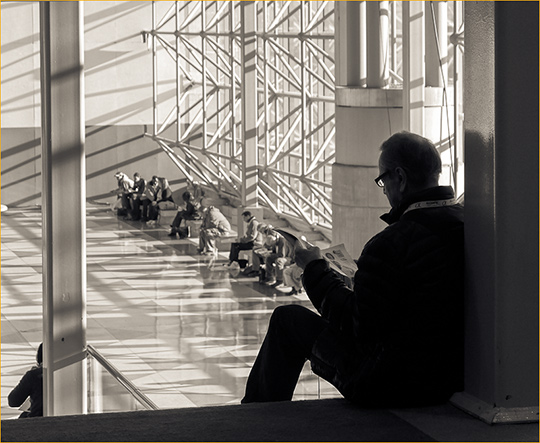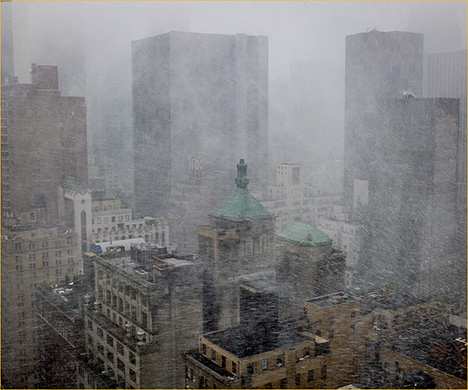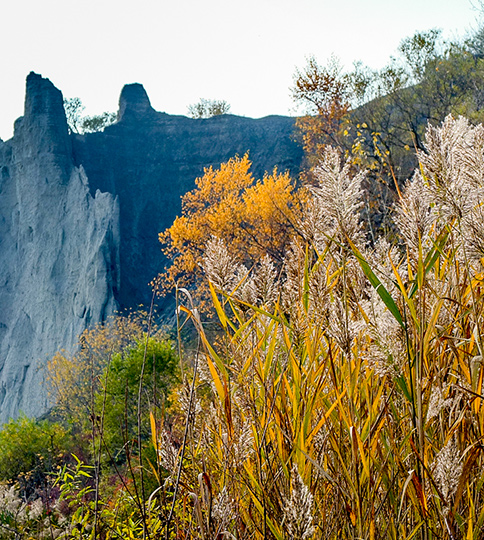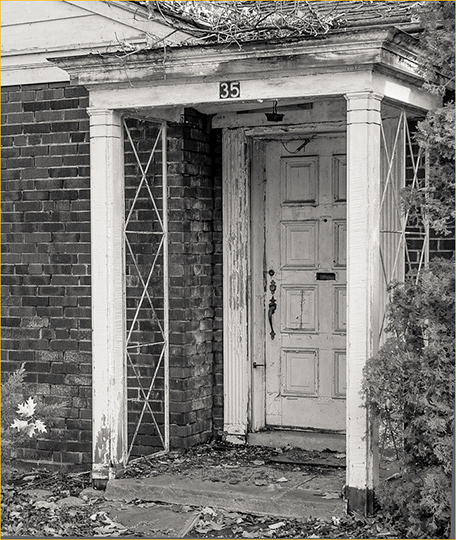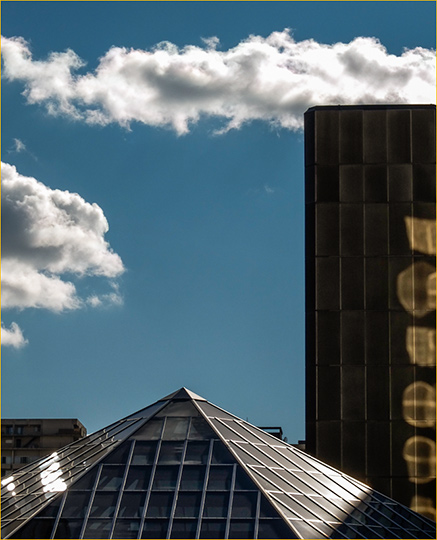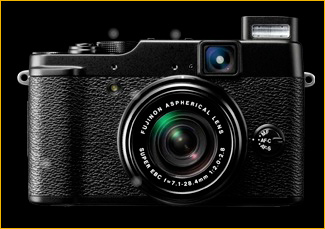
While Kodak lost the plot a long time ago, Fujifilm in recent years has continued to produce some very nice small-sensor cameras. But its DSLR sourcing relationship with Nikon evaporated some five years ago leaving a vacuum for the company at the high end of the market.
Then last year they released theX-100, and all of sudden Fuji seemed to get their mojo back. The X-100 has been a huge hit for them. Beautiful build quality, innovative technology, and fantastic image quality. Aget-back-on-the-horsetrifecta for any photographic company. Now Fuji has dropped the other shoe (sorry for all the metaphors) and as of late October, 2011 has started shipping the X-10.
Reading and Waiting. New York, NY. October, 2011
FujiFilm X10 @ ISO 400
There’s No Free Lunch
Camera design is the art of compromise. We’d all like something that fits in a pocket, has the image quality of a Phase One IQ 180, the low light performance of a Nikon D3s, and the….well, you get the idea.
Sadly, the laws of physics get in the way of our fantasies. The major camera makers are doing a fine job of pushing the boundaries of what’s possible, but there are still fundamental limits. Ultimate low noise requires large sensors with large pixels. Large sensors require large lenses. Fast lenses for large sensors are inherently big and heavy. And so on, and so on.
That’s why there are so many different camera models. Not only are certain design parameters inimical, but different photographers have differing needs.Vive la difference. Which brings us to the new camera from Fujifilm called the X-10. Let’s see where it fits in, and how it performs.
Rooftop Snow Storm #2. New York, NY. October, 2011
FujiFilm X10 @ ISO 320
Where the X10 Fits In
Most very small sensor cameras produce fairly crappy image quality, especially at higher ISOs. To keep these cameras small, yet with a focal length range that people want, means making the lenses slow. Slower lenses means needing higher ISOs, and you end up with,guess what– crappy IQ. Tiny sensors also mean that lenses start to become diffraction limited even at moderate apertures (sometimes as low as f/6.3), and the vicious cycle continues.
Then there’s the issue of viewing. Not everyone likes always having to shoot with the camera held out in front. Eye level viewing leads to greater stability and more intimate involvement in what lies within the frame. Most small cameras don’t offer eye finders, making them less that productive, at least for photographers like me.
Over the past few years manufacturers have developed cameras intended to cater to the serious photographer looking for a camera small enough to fit in a coat pocket or purse, with a moderate zoom range, a relatively fast lens, and a sensor large enough to produce images capable of a decent 11X17″ print, and with an eye-level finder. The current crop includes theCanon G11/12andNikon 7100. TheSamsung EX-1 / TL500are honorary members of this group, though without an optical eye level viewfinder, as is theOlympus XZ-1 andPanasonic LX5, though an accessory EVF is available for each. Otherwise all are coat pocketable, have largish sensors, and fastish lenses.
But we’re here to talk about the brand newFuji X-10, the newest kid on the block. Is it the best though (assuming that we’ve defined whatbestmeans for each of us). Let’s find out.
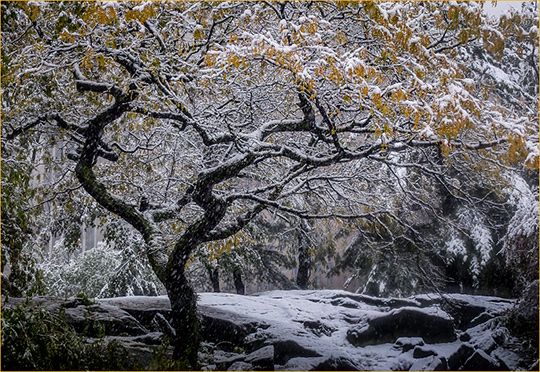
Central Park Storm #8. New York, NY. October, 2011
FujiFilm X10 @ ISO 200
The Laundry List
A Question of Size
The X-10 is not a pocket camera, at least not a shirt pocket. It will fit in the back pocket of ones jeans, or the inside pocket of a man’s jacket. But it will bulge a bit. It’s quite comfortable in the outside pocket of a coat though.
This makes it slightly larger than its erstwhile competition, the Canon G12 and Nikon P7100, but it has a larger sensor and a faster lens than either of these, as well as a far superior optical viewfinder.
Lens & Sensor
The Fuji X-10 has a US suggested list of $600. The camera has a 12 Megapixel 2/3 inch EXR-CMOS sensor. This means that the sensor is 8.8 X 6.6mm (typo corrected) in size, about double the surface area of most pocket digicams. The lens has a 7.1 to 28.4mm focal range, which translates to 28 – 112mm in full frame 35mm terms. This means a 4X multiplication factor compared to standard FF 35mm. By comparison a Micro Four Thirds camera has a 2X factor sensor, while a typical digicam sensor might have a factor of 5X to 7X.
Not to spend any more time on this aspect, but the Pentax Q has a 1/2.3″ (6.17 x 4.55 mm) sensor with a 5.5X factor (smaller than the X-10), while the Nikon V1 has a 2.7X factor (larger than the X-10, but smaller than Micro Four Thirds, which is 2X).
The X-10’s lens is speced as having three molded glass aspheric elements, two ED elements, and has optical stabilization. My field shooting shows this to be a well corrected lens indeed. The sensor and the lens seem to also be very well balanced to each, an advantage of a camera with a fixed lens. This is not the best lens ever, but its very good and it matches the sensor well.
Scarborough Bluffs. November, 2011
FujiFilm X10 @ ISO 100
Zoom Ring
One of the X-10’s singular features, which will appeal to many photographers, is that the lens zooms via a twist ring on the lens barrel. This ring is also the camera’s On / Off switch. To operate, simply turn the ring, which switches the camera on with the lens at first at its widest focal length. Then, if you wish, continue to rotate the ring until you have the framing that you want. This is a very appealing feature compared to the stepped electric zoom function of most other cameras in this class.
The OFF detent is nicely firm and the zoom feel is very linear, with a smooth helical gear moving the lens from 28mm to 112mm in less than 45 degrees.
It didn’t take more than a couple of days of shooting to determine that having a manual zoom ring on the lens, combined with the On / Off switch, is one of the cleverest new camera designs in ages. Kudos to Fuji for coming up with something that is not only unique butreallyphotographer friendly and useful.
Other makers also have lens rings, to wit Canon on the S95 and Olympus on theXZ-1. But none are used for manual zooming, and I would argue that this is a far better application for it than ISO or other less frequently adjusted parameter. Also, since on the X-10 zooming is truely manual rather than fly-by-wire, the precision possible and the tactile involvement will be much appreciated by experienced photographers.
Other Controls
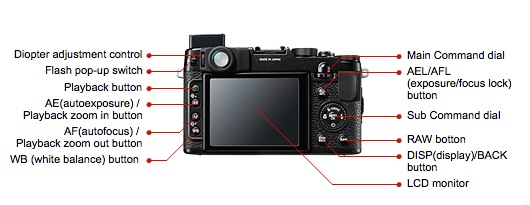
Other than the lens and its zoom-ring-cum-power-switch the only other front control is a focus mode switch, nicely detented and not likely to be accidentally displaced. The rear of the camera is where the action is, and this being a digital camera there are the usual (necessary) complement of controls.
To anyone who has used just about any contemporary camera over the past five years or so, the controls should be straightforward and require little explanation, so I won’t waste your time or mine reciting what each one does. The chart above should be sufficient. Fortunately most cameras now follow a common design ethos, which, like the automobile, means that if you know how to drive, a short familiarization is all that’s needed to pull out from the car rental at the airport in a car that you’ve never been in before. But, just as it may take a while studying the Nav system to get the hang of it, so to each camera has its idiosyncrasies that require some study.
My only real gripe is that the RAW button can’t be programmed to be a second custom function. It’s purpose it to switch to raw mode for the next shot (if one is shooting JPGs), but I find it hard to imagine that many people actually do this. Either you’re shooting raw, or you’re not. I complained about this on theX-100, and almost every other reviewer did as well, but apparently Fuji disagrees on this one.
As far as autofocus speed goes, it’s as fast as any contrast detection system that I’ve used. That means really quite good. The shutter is responsive, and with the shutter sound effect turned off the camera is essentially completely silent.
Menu Interface
The X-10’s menu interface is fairly simple and straightforward. It has a clean design, with only two main sections, a four screen Shooting Menu, and a six screen Set-Up menu. Once the camera has been configured it’s virtually unnecessary to enter the menu system except to Format a card.
But I can’t say that I have high regard for the user manual (PDF). It is comprehensive, but quite opaque on some topics.
The Top Panel

In addition to a pop-up flash the top panel has a hot shoe, mode dial and exposure compensation dial. Both the mode and exposure comp dial are knurled and stifly detented, making them unlikely to be accidental mis-positioned. The shutter release is threaded for a traditional mechanical cable release.
In addition to the standard PASM settings the mode dial has two programmable Custom positions, a Video position, an EXR position and an Advanced mode. More on these in a while.
There is a small button markedFnwhich can be programed to a number of different settings. I’ve set mine to ISO.
Video
Like just about every camera introduced in the past few years the X-10 can shoot video; 1080P 30 in this instance. I didn’t not have the opportunity or inclination to test this capability during my time with the X-10.
Advanced
I’ve always enjoyed taking snapshot-style travel pictures with cameras that have so-calledsweep panoramamodes. This is usually identified with Sony, but Fujifilm has mastered it as well, and the X-10 can be set to produce anything from 120 degree to 360 degree panoramas.

Flash
The X-10’s pop-up flash is just the ticket for fill-flash situations since it isn’t that powerful, but like the flash in the X100 it does fill-flash extremely well. Effective because it’s mostly unnoticeable. The TTL hot shoe is set to accept TTL both Fujifilm’s EF-20 or EF-42 External Flash unit.
Auto ISO
One of the things that Fuji does well is their choice of Auto-ISO settings. The X-10 offers choices of Auto-400, Auto-800, Auto1600 and Auto-3200. In other words, auto ISO, with those settings as the maximum allowable limit. This is welcome, since many cameras only have a single default.
In addition to single ISO settings there is also ISO 6400 M and 12,800 S . What these do is reduce the image size via pixel-binning, thus allowing higher ISOs.
EXR Modes
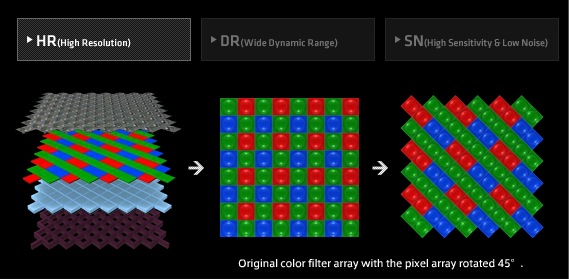
Fujifilm has long taken a unique approach to its sensor designs, and in the new 12MP sensor used in the X-10 has some very clever technology for lowering noise, extending dynamic range and increasing signal to noise ratio. When the camera’s Mode dial is set toEXRthe camera will analyse the scene in front of it and then weighing various factors will utilize one of its special modes to optimize image quality.
These are also available manually, and this is how I would suggest that they are used. The reason for this is that the DR and SN modes involve pixel binning, which can indeed improve DR and lower noise, but it does so at the expense of pixel resolution. In other words, you may find that the camera has decided to take a 6 Megapixel shot instead of the 12 Megapixel shot that you anticipated.
My preference is to shoot in the camera’s full resolution mode and then decide how I want to record it, or process the image according to what it may need. On the other hand, photographers with less time or patience may well be happy to let the camera make these decisions. At least they are there, and they do actually produce enhanced image quality, though at the expense of overall pixel count.
Image Quality
Central Park Storm #5. New York, NY. October, 2011
FujiFilm X10 @ ISO 200
Regular readers know that I no longer do lab tests. I am much more interested in how a camera works in the real world than what the numbers may be.DxOMarkwill have all the graphs and charts that you need before too long.
Raw vs. JPG
I almost always work exclusively in raw, if a camera makes it available. The X-10 does, of course, but at this time the only raw software that supports it is the dreadedSilkypix. Sorry, but life is too short to spend time with software that is less than the best, and sadly Silkypix falls into that category. Therefore, my comments are based in shooting JPGs with standard settings. There are a million permutations and combinations of JPG settings that one can make in-camera, so for better or for worse I just left them at their default settings.
A Plea For Sanity:Fujifilm – please adopt the DNG raw standard. It’s free, it’s robust, it’s open source. It will allow your customers to use the raw processing software of their choice. By sticking with a proprietary raw format you are depriving your customers of long term unfettered access to their files.
With that all said – how do the X-10 JPGs look? In a word, or three, very good indeed.
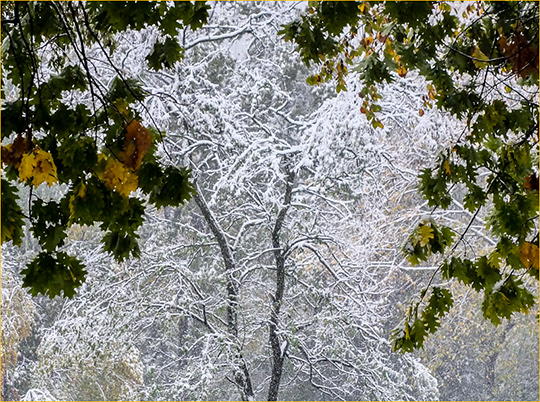
Central Park Storm #4. New York, NY. October, 2011
FujiFilm X10 @ ISO 800
I find out-of-camera JPGs to be slightly oversharpened, but that’s likely just my taste. I’m sure that raws from a good raw processor and then sharpened to taste will be fine. As far as noise goes, there is none to speak of up to ISO 800, at which point it’s visible on-screen at 100%, but hardly in prints. Even 3200, as seen below, is fine. I would judge the noise as comparable to that of an APS-C sized sensor of a previous generation camera.
High ISO

ISO 3200
Small sensor cameras aren’t most people’s first choice when it comes to low light work. But the X-10 will tend to be an exception to that rule because of its fast lens and high ISO IQ. As can be seen in the example above, shot at night at Lincoln Center in NYC, ISO 3200 is quite decent. Even a 100% on-screen crop, as seen below, shows acceptable noise. If this had been shot in raw and with a little luminance smoothing in Lightroom, it would have been even better than the camera’s slightly heavy-handed in-camera noise reduction.
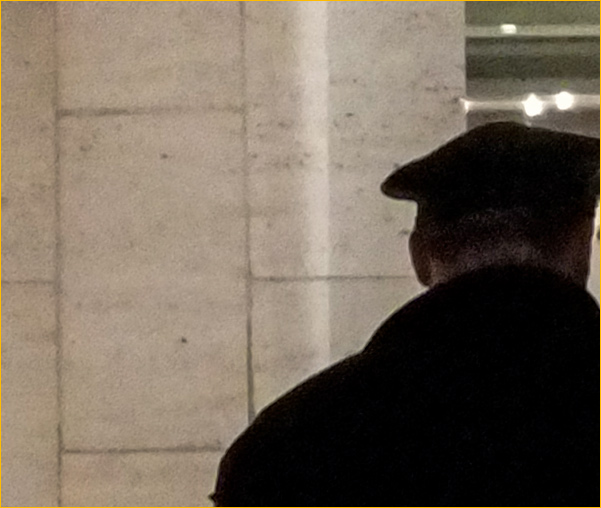
100% Crop
Other aspects of image quality are highly processing dependent, and so I’d be commenting more on the camera’s JPG engine that any inherent sensor qualities. The take-away though is that I consider even the X-10’s JPGs as acceptable for most any purpose, up to ISO 800, except for when strong manipulation is needed, where the use of raw will be preferred.
If you’re a glutton for punishment the camera has a huge number of JPG variables available, including Color Saturation, Sharpness, Highlight Tone, Shadow Tone, and Noise Reduction. How anyone would have the knowledge or patience to set each of these while in the field is beyond me. There are even settings for Film Simulation, with choices of Velvia, Astia Provia and B&W. Oh well, different strokes…..
Battery
The X-10 uses the same NP-50 Li-ion same as F550EXR and F600EXR digicams. Battery life isn’t stellar, but the good news is that generics of these batteries are widely available (Ebay) for just a few dollars. A couple of spares won’t set you back too much, and regardless of what Fuji may warn, these work just fine.
Typo Corrected:The battery is different than the one on the X100, which I claimed when this was first published. I regret the error.
Annoyances and Dislikes
Probably the most serious annoyance with the X-10 is the lack of any focus point confirmation in the optical viewfinder. For anyone that has used a Canon G12 or Nikon P7100 (or their predecessors) which also have optical windows as finders, you’ll likely be scratching your heads and wondering what I’m fussed about. These type of cameras simply don’t have this. It’s not in their DNA.
I know this, of course. But, the optical finder on the X-10 is actually quite good, and though it only shows about 80% of what the camera records, it has a diopter adjustment, a rubberized port so it won’t scratch your glasses, and a pretty good view of the subject and framing. That’s why it really comes as a bit of a shock when you start using it and realize that it’s just a framing window, and not really a useful finder for any other aspect of shooting.
I was also disappointed in manual focusing. It takes far too many turns of the wheel, and even with screen magnification critical focusing is hard to achieve, because the LCD isn’t really that high resolution. This could be ameliorated if some form of focus peaking was implemented, but in this regard the X10 is no better than the X-100, which I also criticised in this regard.
One method of adjusting focus in manual mode is to use the AEF/AEL button to autofocus, then fine tune manually.
Memo to Fujifilm– Please add focus peaking to future models. Itreally, really, reallymakes manual focusing much easier.
Abandoned. Toronto, November, 2011
FujiFilm X-10 @ ISO 100
The other major failing, in my view, is the lack of a tilting LCD screen. I have become quite used to these on a number of cameras. Being able to discreetly shoot with a small camera at waist level is made possible when a camera has one, and is almost impossible when it doesn’t. Also, overhead shots in crowds are another possibility when a camera has one, which regrettably the X-10 doesn’t.
Urban Clouds. Toronto, November, 2011
FujiFilm X-10 @ ISO 100
The Bottom Line
The X10 fits beautifully in ones hand, in large measure because it isn’ttoosmall. I started this report with a discussion of how all camera designs are based on a series of trade-offs by their maker; sensor size vs image quality being paramount. Fujifilm has taken a path with the X-10 that calls for the largest possible sensor in a sort-of-pocketable camera, along with a fast lens of moderate range and a usable optical finder.
The quality of fit, finish and materials is first rate, and belies the camera’s price point. For anyone over the age of forty or so, who remembers when cameras didn’t feel like they were made from molded lumps of polycarbonate, the Fujifilm X-10 will bring a smile to your lips when you handle one, even if you don’t decide to buy it.
Add smooth handling, along with image quality that really does challenge any of its competitors, and you have a compelling camera. It looks like the X-100 wasn’t a one-off wonder, and that Fujifilm really does have its mojo back. With the next shoe (camera) rumoured to drop early in the new year, I can hardly wait.
But there is a spanner in the works. Sony’s NEX, and Panasonic and Olympus’ Micro Four Thirds cameras challenge the X-10 in terms of body size, and have much larger sensors, along with available high resolution electronic viewfinders, touch screens and articulated LCDs. Add a kit lens to one of these and the bulk isn’t even that much more. The price is higher, of course, but not that much higher. And the lure of single focal length pancake lenses for compactness, as well as higher image quality for a not too significant increase in bulk and cost, leaves one to ponder the challenges of camera marketing in today’s rapidly evolving marketplace.
November, 2011
You May Also Enjoy...
Entering The Church
Please use your browser's BACK button to return to the page that brought you here.
